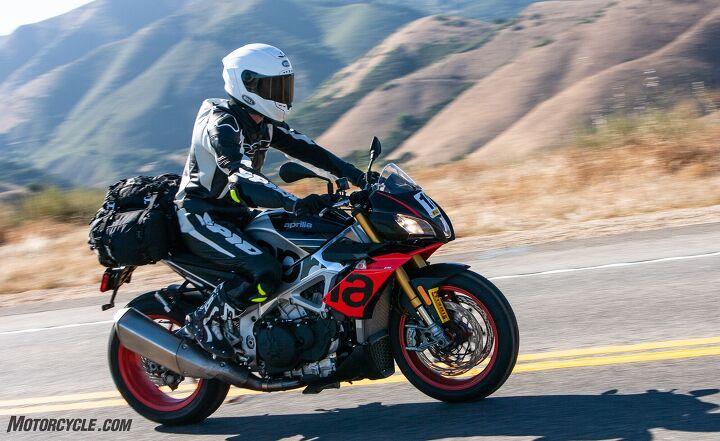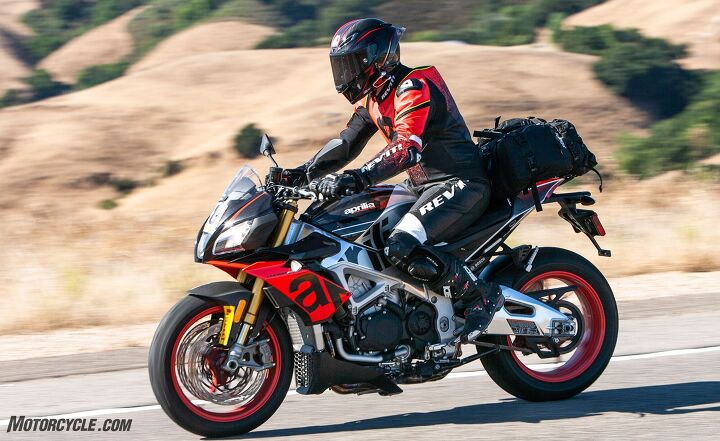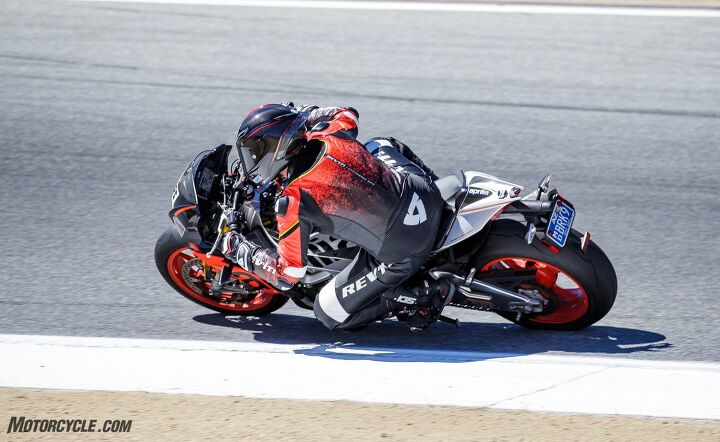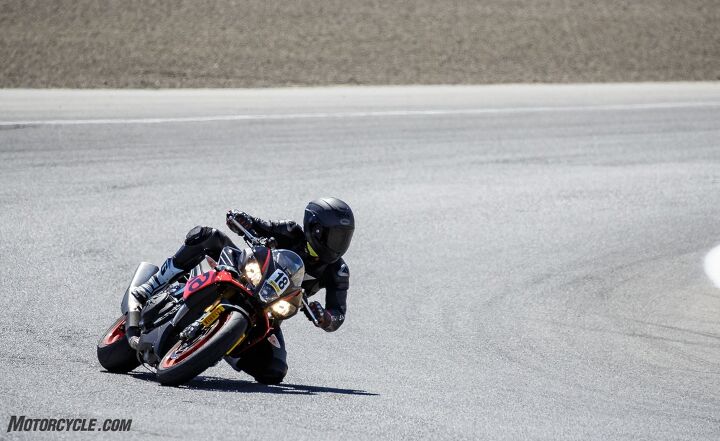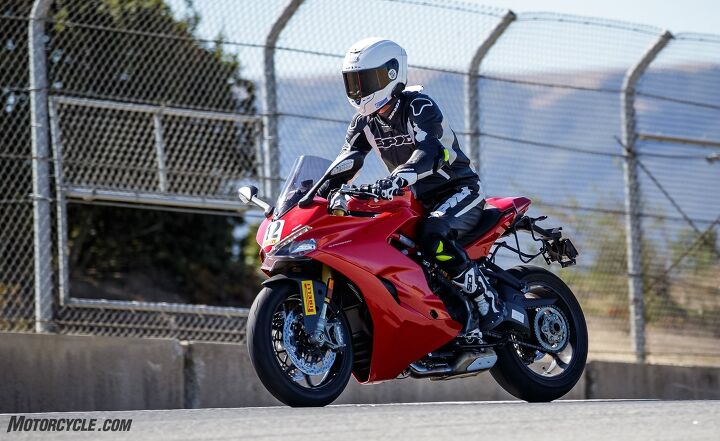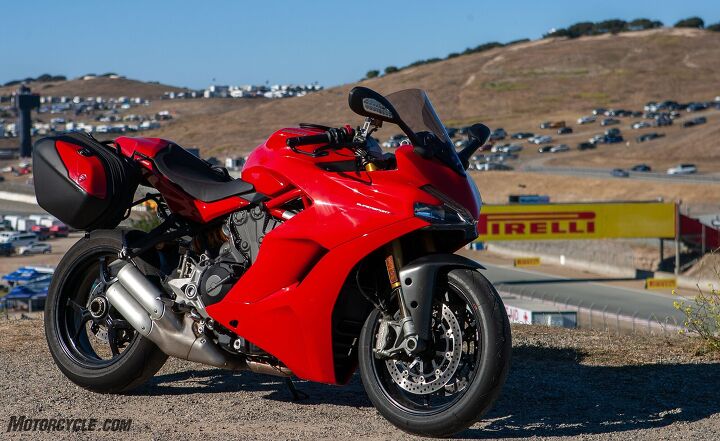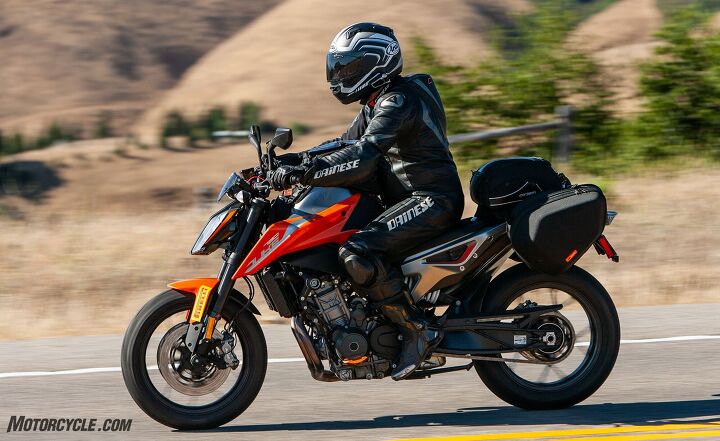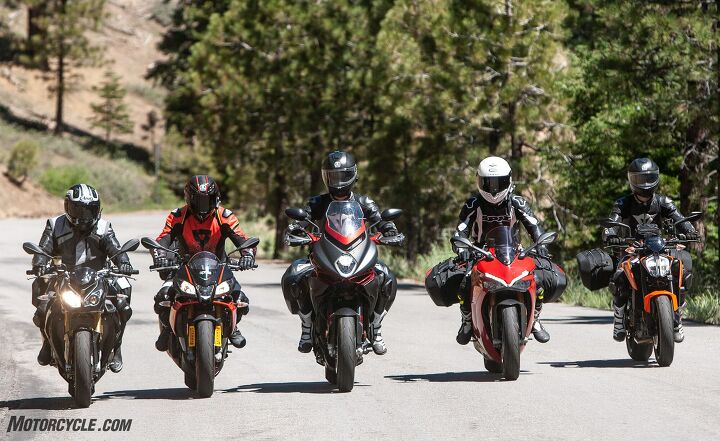Usually when we have a shootout here at Motorcycle.com, the participants are somewhat defined for us. First, we choose a class of motorcycle, and then, we put the latest versions of those bikes in a head-to-head-competition. This time we’re doing something a little different. Each MO editor chose whatever bike they wanted to ride to Monterey, CA, for the U.S. round of World Superbike. The only caveat would be that the bike had to be capable of participating in the annual Pirelli Track Day that takes place the day after the races finish at Laguna Seca. Okay, there was one other rule that I tried to enforce, but the one editor just couldn’t bring himself to choose a bike that had OEM bags available for it.
Get the Flash Player to see this player.
The selection of bikes covers a displacement range from 798cc to 1077cc, and surprisingly, all of them hail from the eastern side of the Atlantic. Only one came with saddlebags standard, and yes, one had no factory bags available at all. Two were Twins (one of the V variety, the other parallel), one was a Triple, one was an inline-Four, and one was a V-Four. All of them had up and down quickshifters, though one didn’t require that the clutch be used at all.
So, without further ado, here are the five bikes, their price as tested, and the rider that selected it:
- Aprilia Tuono 1100 Factory: $19,481 – Ryan Adams
- BMW S1000R: $16,519 – John Burns
- Ducati Supersport S: $17,031 – Troy Siahaan/Ryan Burns
- KTM 790 Duke: $11,292 – Evans Brasfield
- MV Agusta Turismo Veloce 800 Lusso SCS: $22,998 – Sean Matic
The plan for the weekend was a simple one: On Friday, we’d meet at Frazier Park on Interstate 5 for breakfast. We’d shoot video and stills at the higher, cooler altitudes before descending into the hell that is the Central Valley in July, where the temperatures would be ranging from a balmy 99° to an excruciating 105° all in an effort to ride Highway 58, one of our favorite pieces of public tarmac. Oh, and to make the ride more interesting, we’d be wearing the full leathers we needed for the track day since we (I, really) didn’t want to appear to be the pampered motojournalists we are by having one of the manufacturers haul up our track gear for us. Burns, who is just two years older and infinitely wiser (in his opinion), tried to warn me off of the route through the Central Valley, but nevertheless, I persisted. (What was I thinking?) We all suffered as a result.
Once we were settled in our Salinas digs (read Burns’ report about it here), we set about the task of enjoying covering the events of the weekend. When Monday rolled around, we mounted our chosen steed that had been shod with Pirelli’s latest track day compound, the Diablo Supercorsa TD, prior to our departure from our SoCal residences and spent the day diving through the Corkscrew. Tuesday, with sore muscles and shagged tires, we wended our way down the Pacific Coast Highway, shooting more photos and video along the way.
Since this was an atypical shootout, we dispensed with the scorecard because of the wide variance between the bikes. We also decided that, rather than declaring an overall winner, we’d try something a little different and let each rider explain why he chose the bike he did. Afterwards, the rest of us MOrons would put in our two cents worth, which proved to be quite interesting. The goal here is to explore the wide range of machinery that could be enlisted for sport-touring duty rather than same old magazine formula of picking the best of the bunch.
We’ll conclude this article by throwing caution to the wind and letting you, our beloved MOrons, vote on which bike you think should take top honors. (I know you’ll make the right choice.)
Aprilia Tuono V4 1100 Factory
Which bike would you choose to ride 350 miles of backroads up to the world famous Laguna Seca Raceway, do a track day on said world famous raceway, and then ride another 350 miles home? That was the question. And that question took me about 15 seconds to answer: the Aprilia Tuono. It just so happened that the nice folks over at Aprilia had the Factory version available for our little ride. “Sure, that’ll do.”
Just to recap the bike we’re talking about, the Aprilia Tuono V4 1100, is based heavily on the RSV4 1100 which has had its praises sung by nearly every moto outlet for its nimble chassis, fire-breathing 1,077cc V4 engine, and stout electronics suite. The Tuono is, more or less, the same motorcycle with a handlebar lending a more upright riding position. The Factory Tuono comes with an Öhlins fork, shock, and steering damper, all of which are now electronically adjustable for 2019. Aside from the trick suspension, the bike is similar to the standard version that topped the scorecard in our last Supernaked Streetfighter Shootout.
In retrospect, and when considering our motley crew of bikes, the Tuono is the least touring friendly despite having cruise control. Mostly, I say that due to the Tuono Factory’s lack of tail section. There just isn’t a lot of space to pile on luggage. Of course, that didn’t stop me from mounting 55 liters worth of Kriega US-Drypacks on it. With the Kriega luggage fitted on top of the tail section it left just about enough room to sit on the bike and not be able to move around, at least for the smaller of us. Evans was a bit more cramped and made sure I knew it the entire time through our Cardos. Thankfully, I was able to better lash down the straps for the ride home, which provided a bit more seat room, but not much. That was really my only nitpick with the bike as a tourer. If I were touring up to Laguna on my own, I would have just thrown on a backpack and got on with it.

Kriega’s modular US-Drypacks are some of the most versatile luggage for nearly any motorcycle. Because they are easily mounted to each other, you can always buy different sizes of the US-Drypacks to add on later. Here, I used a US-30 for a base with two US-10s mounted to the sides. Not pictured was the US-5 that I kept on top with my essentials (wallet, phone, sunscreen, rear cowling, etc.). This picture shows the bags after I learned to mount them a bit differently to offer more seat room. The downside of using them on this trip was more due to the Tuono Factory’s lack of tail room to perch them on rather than the bags themselves.
I don’t think there’s any denying that the Tuono is the sportiest of the bunch, hell, it’s probably the sportiest naked bike on the market, period. While its sporting character showed through on twisty roads and on the race track, some of our crew expressed their disdain with it being all sport all the time, particularly when compared to the other motorcycles in our crew. I thoroughly enjoyed the Tuono Factory the entire time. Whether it was setting the cruise while slabbin’ it on the 101 or blasting down PCH through Big Sur as I flipped through gears with the quickshifter, I had a blast on the beast from Noale.
The Tuono felt absolutely in its element at the track. The sporty ergos, electronic Swedish suspension, Brembo M50s, and V4 engine were everything I could want and more around Laguna. The adjustability of the Öhlins NIX fork and piggy-back monoshock is something I wish I could have spent more time playing with. You have three levels of active suspension as well as three baseline settings for manual modes, all of which can be independently adjusted to fine tune the rider experience via the left switch gear and TFT display. I became comfortable on the Tuono around Laguna Seca from the moment I left pit lane. I spent three sessions on board the Aprilia, and after bumping up the preload front and rear, I felt even more confident on the bike. With the APRC package, including adjustable lean sensitive ABS, traction control, wheelie control, launch control, and up and down quickshifter, the 2019 Aprilia Tuono is easy to ride hard. Like a trust fall, it can take some initial courage to grab a handful of gas on an 1100 V4, but after you do and can feel the electronics keeping the bike composed, it’s like the little devil on your shoulder saying, “I’ve got your back, just go for it!” And go for it, we did.
I suppose it can’t all be cherries on top, though. With the Tuono, Aprilia increased displacement from 1000cc to 1077cc, ensuring gas mileage would continue to be dismal on what was already a thirsty engine. During our test we averaged 27.6 mpg on the Tuono. But hey, that’s only 10 empeegees less than the next worst gas hog, the BMW S1000R at 37 mpg. Yikes! While the fuel mileage is awful, I have come to expect it having my own 2015 Tuono V4 (1000cc) and it has never really bothered me… except that one time I coasted down from the top of Nacimiento road in neutral through the dark to Hwy 1 because I was worried about running out of gas in a fuelless stretch of Big Sur.
At the end of the trip, I was happy to have chosen the Tuono. There was never a time I wished I was on one of the other bikes. And though it’s been cute watching the other kids defend their bikes – John and Evans in particular – it’s been interesting to see how everything shook out. Evans, John, and I all stand steadfast next to our choices while Ryan and Sean could admit they had more fun on one (or all) of our bikes around Laguna while still remaining quite content during the touring portion with their choices. I guess that makes us all winners in one way or another. Gold stars for everyone!
Mr. Matic – Motor, motor, motor. Did I mention that sweet V4 motor? Every year for ten years on now Aprilia refines the Tuono platform and for 2019 it does not disappoint. New dynamic suspension for 2019 was the firmest of the lot as it was set up but worked great on the track and on the twisty roads. Superbike brakes led the pack, too. The Tuono is, for sure, a bike I’d rank high on my list for something to ride up the coast and then do a trackday on, but since I own a 2016 Tuono and needed to haul some gear in addition to a change of clothes, the Aprilia was not my choice this time around. With no real wind protection, 25 mpg, the highest footpegs of the lot, and the motorcycle equivalent of a G-string bikini for a tail, the Tuono is not the most practical motorcycle for eating highway miles or hauling five days worth of clothes, but on Highway 58 or blasting over Turn 1 at Laguna Seca none of that matters.
EvB – The Aprilia is the sportiest bike of the bunch, and the riding position reflects that. Still, get it on a smooth winding road – from sweeper-filled to super tight ’n technical – and let the engine sing. In one sinuous section of Highway 58, the Tuono’s exhaust note almost had me convinced that I’d made the wrong choice with the KTM. Suffering through the bumpy cut and thrust of Santa Rosa Creek Road on the Aprilia dispelled me of that illusion (or was it delusion). Ryan’s packing job didn’t do the bike any favors, either. I almost eliminated the Tuono from the test since it didn’t have factory bag options, but when Ryan threatened to hold his breath until he turned blue, I relented. But, oh boy, that exhaust note…
Johnny B – Performance-wise, I think it runs neck and neck with the S1000R; both bikes’ horsepower and torque ratings are within the margin of error of the dyno, and they’re equally a blast to ride around Laguna Seca. I wouldn’t be surprised if my lap times were virtually identical on both of them. If anything, the Tuono’s vestigial fairing and slightly tighter ergos maybe give it a slight edge around Laguna Seca.
On the road, though, the BMW just fits my off-the-rack 5’8 bod better than the Aprilia. They may have changed the bend of the Tuono’s handlebar in the last year or two, because this one is more agreeable to me than the last Tuono I rode, but the Tuono’s seat doesn’t get along as well with my rear end, it’s a bit thicker in the midsection than my BMW, and its footpegs aren’t ideally located for my legs either.
32 mpg or less is really unacceptable in the modern world.
The Tuono demands your full attention every time you turn it on, and sometimes I just want to ride, without all the drama. It’s like a high-energy friend you’re watching down another Red Bull/vodka. You’ll be needing to plot your departure… Most of the time. BMW calls the S1000R a “Roadster,” and that’s what I like, it’s a wolf in sheepish clothing. The fact that it’s 22 pounds lighter than the Tuono just makes it easier to roll around on every day.
In spite of all that, at least the Aprilia’s got cruise control, and I’d be happy to ride it anywhere with a tank bag full of clean undies to lean upon provided there were gas stations no further apart than every 100 miles.
Ryan Burns – Ryan Adams is a masochist. Just kidding, but the way his Kriega tail pack married your battered giblets with the gas tank sucked the fun out of the “touring” aspect of this trip on the Tuono. In terms of comfort, I imagine with a different, more freeing luggage set up, this bike would be fine for some touring action. Its upright riding position was not punishing.
Everyone knows this bike is a beast and that it rips like one (in a good way). Equipped with a beautiful powerplant, and superb electronics across the board, the Tuono is a track day weapon and potentially capable tourer. 4.5 crushed giblets out of 5.
2019 BMW S1000R
I remember being a huge fan of the S1000R in our last 2017 Super Naked Streetfighter Shootout!, when it finished (just barely) third behind the KTM Super Duke R and the Tuono. In that one, we did ride all the bikes three hours out into the des for a date with Chuckwalla Valley Raceway, but that’s maybe half as distant as Laguna Seca, and we didn’t prioritize luggage capacity at all. (We must’ve thrown all our stuff in Jay McNally’s Grand Caravan videomobile/ chase vehicle.)
The Super Duke GT, which comes with nice saddlebags and which KTM classifies as “Sports Tourer” could’ve easily worked on the ride to, on and from Laguna Seca. But Brasfield had already made clear he’d be taking the 790 Duke, and two KTMs out of five bikes was a no-go. Little Ryan Adams had already proclaimed his devotion to the Aprilia Tuono, so that was out – and I’ve never been as huge a fan as the other MOrons anyway.
That left the BMW S1000R for me, which would’ve been my first choice for this mission anyway. For one thing, the BMW’s at least 20 pounds lighter than the other two, and for another thing the seat is lower – especially compared to the KTM. When you’re tip-toeing around in gravel turnouts and climbing on and off all day for gas stops, video shoots, etc., it adds up, and for 5’8” me, the more compact BMW is just less fatiguing on a long ride. If the BMW’s ergos aren’t quite as comfy as the Super Duke’s, they’re very close: The BMW cants its rider into the wind just a smidge more than the Super Duke does – which I thought would be the perfect compromise between 85-mph superslabbin’ and cresting Turn 1 at Laguna at 130-140 mph.
Turns out, as usual, I was 100% correct. Set to Road mode, the BMW serves up a compliant ride on the freeway that’s as firm and sporty as you need it to be when the curves appear (well, actually you just thumb it to Dynamic Pro when you come to the curves, without stopping). It was nice and warm most of the way up, so I didn’t miss the fairing in the least, especially since I was wearing my perforated, snug Dainese leathers and nicely aerodynamic Arai Signet X. When it was hot, letting a couple mouthfuls of cool water dribble down into my Capilene undies cooled me right off.

If I’d noticed the big zippers that let each bag expand from 10 liters to 16 (10L in this photo), I might not have needed the backpack I cargo-netted onto the passenger seat. The factory bags aren’t cheap, but they’re typical BMW: Quick-removable aluminum rods extend back from the passenger peg mounts to hold the bags in place, and the zipper tabs have holes for a small lock to deter casual thieves.
Popping off the passenger seat let me easily throw on BMW’s accessory Saddlebag Kit ($574). With the bags in place, you could easily carry a passenger without neutering them, unlike the Tuono. Without a passenger, it was easy to cargo net-on a backpack with more gear and my Kriega water bladder, which we would’ve perished without.
At the track, it was a simple matter to roll across the pit and have BMW Motorrad’s Steve Weir provide me with some “spring support” along with some emotional, as he dialled up more preload at both ends along with all the proper settings in Dynamic Pro mode. “Road” had not been bad at all in session one, but Steve transformed the R into an even more solid platform upon which to exploit the crazy grip of the Pirellis. Wish he could recalibrate my brain. You know Dynamic Corner Entry Speed Control is on the way.

I ride my little heart out all day and the track photographer gets one shot of me on the cool-down lap with the wheels frozen. Typical.
The handlebar and no fairing slowed us down a bit, but I was happy to trade a few mph for the increased confidence the sit-up ergos gave me, and you can grip the skinny BMW nicely between your knees and hunker down pretty good on the straights – enough to blow past many motorcycles with less than 160 rear-wheel horsepower; that would be most of them. Some of us complained two years ago about our last S1000R feeling a little skittish on its optional lightweight wheels. This year’s loaner doesn’t have the expensive wheels, and with its standard steering damper, it remained solid as a freight train at all times. Maybe I should’ve tried to go faster? Why be greedy?
Shift Assist Pro was rather amateurish on the last RR I rode around here; on this R, it is fully sorted, and all you have to do for the final turn 11 is brake as hard as you dare and tap, tap, tap with the left toe down into first gear, perfect every lap. (Interestingly, the Beemer had no problem making up a lot of ground in a couple of heavy braking zones on a certain Tuono-mounted person who criticized its brakes. Maybe one of those squeezy-grip workout devices is in order?)

The Tuono’s almost as good as the BMW around Laguna Seca, but I don’t think you’d wanna ride on back of it back to LA.
Pin the throttle, and the Panigales and bikes with number plates weren’t driving much faster up Laguna’s front straight. I think I saw smears of orange and red flak once or twice, moving rapidly rearward, that may have been the 790 Duke and Ducati Supersport. With the Akrapovič muffler that’s part of the Select package howling, and popping now and then on decel, this thing makes the hairs on the back of my neck both stand up and be blown down perfectly flat, respectively. If this is lack of character, then I’m a wart hog.

BMW’s bland, characterless 160-horsepower inline-Four nearly put some of our testers to sleep as it shrieked to redline and popped on decel through the accessory Akrapovič can that’s part of the Select package (along with the excellent up/down quickshifter, heated grips and cruise control). On the dyno two years ago, the BMW made 160 hp to the Tuono’s 162, but did it 900 rpm earlier, at 10,900. The boring BMW engine also made 2.5 lb-ft of torque more, at the same 9500 rpm as the bigger Tuono V4. Did I mention the BMW’s like $3000 less expensive than the Italian job? And 20-some pounds lighter?
On the 16-hour ride home, some kind of small fairing would’ve been nice after dark (until it warmed up after Pt. Concepcion); the aftermarket is full of them. Other than that, it was the BMW’s bright headlight, warm grips and cruise control that set the pace most of the way home, quite comfortably. A soft tank bag to lean on and block wind would’ve made it unimpeachable.
What would you expect to pay? Only $15,945 including the Select Package ($1950), which you definitely want since it includes Cruise Control, heated grips, quickshifter, DDC, DTC, ABS Pro, and the Akrapovič can. You’re looking at the same level of performance as the Tuono (some would say maybe a bit more), for almost $3000 less. But wait, there’s more! Heck, it’s even way cheaper than the Ducati. I think the S1000R is one of the best performance bargains out there. If you still crave superbike performance in a daily rider but don’t want to assume the position, this is your bike.
Second Opinions…
Ryan Adams – The Aprilia and BMW were the two sportiest bikes of the bunch by a long shot, and while I’m happy to say I would pick the Aprilia again everyday of the week and twice on Sunday, the BMW was a close second. It has comfortable ergonomics, the second most cush seat after the MV Agusta, top-o-the-line electronics, great handling, and plenty of power from its inline-Four. Even with the 999cc BMW S1000R’s 160 horsepower mill, it still felt a bit bland, that is, unless you’re keeping the engine screaming high into its powerband around Laguna Seca, then it’s plenty exhilarating. An inline-Four just doesn’t have the character I look for in a naked bike. On the street the S1000R’s dynamic suspension felt great, but I would have liked to have had more time to get it stiffened up while on the track. One of the few nitpicks I have with the S-thou-R is the brakes. After using the Tuono’s Brembo M50s, the BMW’s binders simply don’t have the effortless power the Tuono’s braking system provides. I could say the BMW is the better touring bike. There’s more of a backseat to strap luggage, it has heated grips (with the package we had equipped) and the fueling is smooth at any rpm, whereas the Tuono chugs a bit off the bottom. All things considered, I always looked forward to swinging my leg over the S1000R during our rotation, it just didn’t deliver the same visceral excitement of the Tuono’s V4 powerplant.

BMW’s weak-ass 320mm dual discs and four-piston Brembo stoppers, activated by Nissin radial master cylinder via stainless lines. The sensible Germans probably spec a less aggressive pad than the crazy Italians.
Sean Matic – Another liter bike with a rocketship of a motor that pulls from bottom to top as its centerpiece. I’d give the nod ever so slightly to the Aprilia for connection between the right wrist and the rear contact patch, but it’s almost too close to call. Dynamic suspension works very well on the BMW, it handled both the G-force loads of Rainey Curve and the bumps of Santa Rosa Creek road very well. As JB had it set up the fork felt a tad less controlled on the track than the Tuono and slightly plusher in the canyons. The front brake did the job but not with the absolute power and control of the Aprilia set up. The fact that BMW offers factory saddlebags and there’s real room for a tail bag makes this Bavarian street fighter a great choice for a sporty mount that can do a long weekend trip and then shame full-on sport bikes on the race track. The analog tach and digital LCD screen looks so 2017 compared to the lovely TFT displays on the Aprilia, KTM, and BMW’s own S1000RR and GS.
Evans Brasfield – Within the guidelines set out for this shootout, I suppose I’d choose the S1000R if I were forced to choose a liter bike. It has a great riding position that I could ride through an entire tank of gas and all the luxuries (read cruise-control and heated grips) you could ask for. We did ask for saddlebags, and we were given BMW’s cute little glove holders. I think I would have added a tank bag to the mix were the BMW the mount I had to live with on an extended ride. Although the engine’s power was on the same order as the Tuono’s, it was my least favorite mill of the bunch with its inline-Four blandness – at least until you twisted the throttle to the stop. In the end, I found it a bit more practically equipped by its OEM for touring than the Aprilia and probably just about as much as a track machine.
Ryan Burns – I actually preferred the power delivery and overall planted feeling of the BMW over the Tuono on the track. Additionally, those cute little panniers are an option and are better than nothing. They can hold a total of 32 liters when expanded. I’ll admit it doesn’t have the “panache” (“drip” for those without an AARP subscription) of the Tuono’s styling and angry V4, but let’s be objective here.
Ducati SuperSport S
I’ve had my eye on these since they first came out in 2017, so thank you, Troy. [Troy initially requested this bike for the ride, but when he had to bow out of the trip for family obligations, Ryan was a more than willing participant in our shenanigans. —Ed.] To me it brings together all of the things I would look for in a bike I might actually purchase. I’m not at the stage in my life (…yet?) where I am able to buy a few bikes for a few different tasks, the SuperSport is versatile as hell, and dammit, it looks sexy as hell. Italian racing DNA/Panigale looks, decent performance, and perfectly capable (and equipped) for touring. That’s a lot for one motorcycle. The adjustable windscreen, relaxed riding position, and 50 liters of storage (both bags extended) were awesome on this trip. Pop those puppies off in two seconds at your destination, and you’re back to looking freakin’ tight for the night, bruh.

The expansion zippers make the bags look a bit saggy, but when you’re free of a backpack and/or a cargo net, you won’t care.
This bike shined on the way to the track, where you can flow and keep things in its powerband. The liquid-cooled 937cc Ducati puts into this one, which it rates at 110 horses and 69 lb-ft of torque, seems like more than enough on the street. It was only when hitting the track, where you’re braking hard and popping down multiple gears, just to fly right back up through them, where you’re reminded that this thing only looks like its V4 pappy.
At least the quickshifter, part of the S package, makes all that shifting easy. The other part, an Öhlins shock and 48mm TiN-treated fork, keep things painless and under control. On some of the straights, I learned the difference between 110 hp and much more, but I still had a blast riding the Ducati. Its amount of power seems to pair nicely with its amount of everything else; I’d say it’s nicely balanced. And for me, track days are few and far between.
A few more cc could go a long way, hopefully we see a 1200cc or something along those lines in the coming years (forums rumor a baby V4?).
On the long, cold (at first) ride home, I was glad to be behind the adjustable windscreen, but sad that the heated grips needed to be activated by your friendly Ducati dealer, who was nowhere around on a Tuesday night in Cayucos. I guess cruise control would’ve been good, but I was having such a pretty surreal time blasting tunes through my Cardo under a full moon that lit up the Pacific Ocean, that holding onto the gas didn’t really seem like a big deal. Maybe when my joints creak.
Final complaint: This thing gets hot. It was 90 degrees in Orange when I rode home from work today (back to the office); I looked down at my dash as I flared my supple thighs and saw the Testastretta 11 idling at 228 on the LCD display. Not a deal breaker, but forewarning.
Notes from the elders:
Ryan Adams – This lil torque monster was the sleeper of the bunch for me. Once we reached the smooth serpentine pavement of Hwy 58, I was dragging hard parts in no time. The Supersport’s 937cc Testastretta engine is a hoot to lug into a corner and fire out at the twist of the wrist. I was upset to have not had a chance to ride it around Laguna, but from what I’ve heard from others, that may have been where it was out of its element. I’ll just focus on the good times we had on public roads. The comfortable, albeit slightly sporty ergos proved to be comfortable mile after mile, and the strong pull from the engine made this Duc a great all-rounder. Combine that with the large expandable bags of our S model and you get a bike that will absolutely rail in the canyons while still managing to commute or tour with aplomb.
Sean Matic – A sexy comfortable canyon carver with matching roomy expandable factory saddlebags. This bike is a great choice for someone getting into sporty bikes but still learning the art of sportbike riding – plenty of power to get you there and haul you over hill, dale, freeway slab, and up the backside of the Corkscrew but not so much power to get the newer rider in over their head. The bike does a good job of bridging sport-tourer and sportbike, superbike and middleweight, clip-ons and comfort. One of the biggest praises I can give the SuperSport is it’s fun and comfortable on the road and freeway but the chassis, suspension, and brakes have excellent composure when pushed hard on the track or on the twists and turns of Highway 58. While the rest of the guys were complimenting the torque of the Ducati V-Twin, to me it felt a little anemic in the bottom and lower mid-range, (kind of like a Ducati 959), but keep the Ducati in its rpm sweet spot while riding with more flow than stop n’go, and it hauls the mail!
Evans Brasfield – What initially struck me about the Ducati Supersport was that its odd, feet-forward-ish riding position (compared to the others) seemed to work. The V-Twin’s grunt made quick work of the winding roads we encountered, and the fairing looked awfully nice when we were battling the headwind on our dash up the 101 to attend Ducati’s Panigale V4 25° Anniversario 916 unveiling. The Duc’s bags looked quite roomy, though they tended to droop in the expanded position when fully loaded.
John Burns – I’m so glad my boy had the chance to ride this, because he was actually talking about buying one there for a while. You can tell your kids things, but it’s better for them to experience them. The SuperSport is a great last-generation motorcycle for current-generation money. This is a perfectly nice $12 or 13k bike, but there’s no excuse for it to cost almost as much as the Tuono, and more than the BMW. No IMU means no lean-sensitive ABS or modern traction control.
Did I mention you have to remove both of those exhaust tips to change the rear tire? Count on another hour of labor.
Other than that, the bike is a pleasure to ride on flowing backroads. But then, so are the BMW, Aprilia and KTM – two of which destroy the Ducati on the track and one of which outhandles it on twisty backroads.
Comfortable enough on the long freeway drone home, but again, for the money, no CC is inexcusable. It has heated grips, but they need to be activated by the dealer, and then you’ll need to negotiate with the computer every time you want to turn them on or off or up or down. My BMW has a button. The SuperSport is my least favorite bike here, sorry.
2019 KTM 790 Duke
I’ll admit it, I had an agenda with my choice of the KTM 790 Duke. No, it wasn’t just an excuse to ride a bike that I’m clearly smitten with. Rather, I was certain that all the other MO staffers would choose big, powerful, heavy, expensive bikes for their Laguna Seca ride. I envisioned a David versus Goliaths confrontation, in which the Duke, thanks to its versatility and low price, won over my compatriots. (Like that would ever happen to those horsepower drunk moto-junkies.) Then, Sean Matic blew the whole idea up by choosing another 800. Although given the MV’s price, much of my original concept still stands.
2019 KTM 790 Duke Review – First Ride
A Disruption In The Force: KTM 790 Duke Vs. Triumph Street Triple R
Live With This: 2019 KTM 790 Duke Long-Term Review
There is a certain logic behind my choice. Not every rider has the bucks to buy a liter bike. In fact, most people will do what I did and enlist the bike they have for a trip like this. They adapt their machine to the task, and the Duke is uniquely flexible in this regard, being able to change personalities simply with the addition of groups of accessories. For example, installing the factory accessory saddlebags was as simple as bolting on the mounting brackets. (Though, oddly, I did have to remove the KTM PowerParts Akrapovič slip-on to do it. Something BMW was able to accommodate with its Akra and accessory bags.) Boom, instant sport-tourer. Elapsed time? 45 minutes. The only thing I really missed on this ride was more wind protection, and KTM has a windshield available for a reasonable price. Next time.
To me, that’s the beauty of the 790. First, you start with the $10,499 retail price, and once the saddlebags are installed, the price as tested moves to $11,292. That’s still $5,227 less than the next closest member of this shootout and a whopping $11,706 from the most expensive. Plus, you still get top-shelf technologies like cornering ABS and an up/down quickshifter. Yes, cruise control would have been nice for the ride up and back (maybe on the 2020 model?), and the performance rider in me says KTM should have given us the option to pop for WP’s adjustable suspension. Still, for a comparatively modest layout, you get an extremely versatile motorcycle. With the right accessories, you could alternately set it up as a hooligan bike, a sport-tourer, and a track toy (though admittedly one more suited to tight, technical circuits) – all for less money than any of the other bikes here. Hell, you could even buy OEM heated grips for winter commutes.
So, what’s it like bringing a Swiss Army Knife to a gunfight? The only place I felt totally outclassed was on the straights at Laguna Seca. Even then, I still managed to pass many riders who were on more powerful bikes once the time came to hit the brakes. Get the KTM on a tight mountain road, and with its light weight, supreme maneuverability, and real world power output, it keeps up surprisingly well with the much larger machinery. Even loaded down, the 790 was happy to go all day in freeway cruise mode. It just needed more wind protection for that upright riding position.
Let the other guys mock the Duke for its mere 60.2 lb-ft of torque, 98.0 hp, and non-adjustable suspension, I’ll take the 790 Duke’s blank slate versatility. Last week it was a sport-tourer. Today, it’s in urban hooligan mode. Next week or next month? Adjustable suspenders and rearsets? We’ll see what tickles my fancy.
John Burns – A perfectly nice little run-about, but I don’t know why for this particular exercise EB didn’t pick the KTM Superduke GT? It’s twice the money, true, but if the goal was to go on a long tour and run fast lap times, the little 790 just found itself outgunned. Laguna’s straights haven’t seemed so long since we compared 400s last year, and there weren’t even people on Panigale V4s bombing past then. At least the little Duke drafts well; stuffing a certain Tuono rider on it into the Corkscrew was one of the high points of my day. (PS: If EB had picked the 1290, then I’d have countered with: it’s too much, too thirsty, too over the top for my taste, really, and too tall for my stubby little legs.)
Ryan Adams – The KTM 790 Duke is so much fun to ride. The Parallel Twin motor, the absolute flickability of this little orange bean. So. Much. Fun. But ya know what, when you start comparing it side by side with bikes like the S1000R and Tuono, it begins to feel lacking in a handful of ways. Evans’ penchant for bringing everything and the kitchen sink and then strapping it on top of the poor little KTM didn’t help during our ride up and back. I shouldn’t tease him for it though; I appreciated the full size can of polish and microfiber each time he offered it to me so I could clean my helmet’s visor. Even when the KTM was stripped of its textile shackles, it felt under-powered at Laguna Seca. The track’s significant elevation changes and long straights didn’t do the lil’ guy any favors. The 790 boasted the most supermoto/upright seating position, yet for me, during my single 15-minute session on the track, it left me looking forward to the checkered flag. After experiencing what the BMW and Aprilia had to give, the 790 just felt lackluster in the scenarios we thrust it into. All of the time I’ve spent with the KTM 790 Duke on its own was enough to have me thinking about how nice it would be to have in the garage permanently. I still feel that way. But for this exercise, the 790 falls a little short of the pack, in my opinion.

The KTM PowerParts saddlebags were handy for transporting my clothes on the tour. The 11 lb. limit meant that my camera gear needed to be carried in a tail bag. Getting both plastic (!) clips securing each bag to their bracketry to click into place occasionally required that I reach inside the bag to press as close to the clip as possible. Waterproof liners and covers were included.
Sean Matic – When it comes to street bikes, the orange Austrians always seem to do things a little outside of convention, and the Duke 790 holds true to that design philosophy. Maybe that’s why Bossman Evans fell in love with the little 790? Parallel-twin with a staggered firing crank, stuffed in a backbone frame. Upright almost dirtbike ergos with low pegs. Full electronics suite with a lovely TFT dash on a super middleweight, but paired with non-adjustable suspension and somewhat budget brakes. The end result is best summed up in two words: lightweight FUN. The KTM makes the least power of the five bikes and signs off the earliest, but it doesn’t matter – it’s a fun, joyful, and nimble bike to throw around a twisty road or racetrack. It looks as sharp and as lightweight as it feels. Ring the throttle, bounce it off the limiter to see the pretty dash light up bright orange, throw another gear at it and repeat. I can’t really fault KTM for the budget suspension and brakes at the price point they bring the bike in at, but the ergos do take a little getting used to jumping off about anything else.

They rib me for overpacking, but who had tools when they needed to remove mirrors? Plus, it sure was nice having a clear visor for the night ride home. (Just sayin’) The Wolfman Blackhawk Tank Bag is just the right size for the 790’s tank.
Ryan Burns – A fun, nicely built, and affordable midsize machine loved by many. It’s parallel twin is versatile and torquey, and I think with some further suspension adjustments to plant it more it could have been helpful on the track, but I still enjoyed myself. This thing would be insane fun at your local kart track.
I think for touring and track days however, I would in general go for something with a bit more mass and power. Getting blown around the highway and wringing this thing in its upper rpm range for hundreds of miles isn’t ideal.
MV Agusta Turismo Veloce 800 Lusso SCS
When Evans told me I’d be going to Laguna Seca for World Superbike with the boys to make a video, I figured it would be the normal routine with me playing chase in my SUV hauling my video and audio gear, Evans’ camera bag, John’s chilled Evian mist bottle, and everyone else’s backpacks. This time, however, I’d actually get to join in the fun and ride a motorcycle to and from Laguna Seca – and I got to choose the bike I’d be riding.
The only catch? I’d still need to be able to haul enough video gear to appease our admiring YouTube audience. Unlike the rest of us MOrons, I don’t usually test ride the bikes we cover (though I do sometimes get a quick blast around a corner or two). So, I wanted to make the most of my choice by selecting a bike I had not ridden before and wanted to get to know better. There are some bikes I have ridden which I adore that would have made a fine choice for this assignment, but I’m more of an “Oooh, lets try that new Uni with squid ink tagliatelle on the menu” rather than a “just give me the cheeseburger and fries please, Bob” kind of a guy.

When your job description calls for carrying tons of video gear, spacious, lockable saddlebags are important. Still, I had to add a tail bag, too.
Enter the MV Agusta Turismo Veloce Lusso SCS, the manufacturer’s first attempt at a sport-tourer featuring an unconventional 800cc triple with a counter rotating crank, hands-free American-manufactured Rekluse Smart Clutch System (SCS), and sexy Italian styling that included stylish lockable/removable hard saddlebags for my gear – all based on the potent F3 platform and a good bit lighter than Ducati’s MTS. Sign me up!
The first thing that struck me about the Turismo Veloce when MV Agusta USA’s Marketing Specialist, Jose Gallina, gave me my introductory run through was that the seat looked tall (33.5”) and the bike was equipped with an Automatic Rekluse clutch! Both happened to be true and both turned out to not be a problem. I wasn’t aware of the SCS option on the Turismo until the moment Jose walked me through the ins and outs of the MV Agusta’s interface. To be perfectly honest, I couldn’t understand the need for an automatic clutch system on a sporty European bike equipped with MV’s EAS 2.0 (Electronically Activated Shift) up and down system.

The spinning clutch assembly under the glass was an attention-getter. The ease with which the MV’s Smart Clutch System and quickshifter made handling every riding situation is hard to overstate.
My only experience with a Rekluse clutch was the one time a friend let me ride his Rekluse-equipped KTM 200cc 2-Stroke trail bike. Having honed my childhood riding skills with one finger on the clutch lever at all times on a 2-stroke 125cc motocrosser, I found the system on the little KTM made me feel a bit disengaged from what the rear tire and drive train were doing. I couldn’t really fathom its use on street bike.
It turns out that the Rekluse system, combined with the MV’s Eldor ECU, perfectly calibrates clutch slip for you every time, making manual clutch slip from a stop completely unnecessary. The only thing I could find that the Rekluse system didn’t do automatically is extend the slip slightly during times you might like to further smooth your take off. At those times, the rider is free to do so manually.

Fully loaded down with camera gear and racking up the miles. The MV was the one to be on for road-gobbling stints.
I know the F3 based triple platform has received criticism in the past for jerky on/off fueling at low revs and throttle openings, but the TV pulled cleanly and smoothly from a low as 1,000 rpm. The MV triple can feel a bit sprightly on take off and initial throttle openings, but that felt like more of a function of the oversquare architecture of the triple motor, a light flywheel, and the Rekluse system not over-extending clutch slip. The fueling always felt spot on to me. After my first five minutes in heavy stop-and-go LA traffic, I quickly appreciated the Rekluse’s ability keep my left hand relaxed.
The quickshifter worked great up and down with perfectly matched revs from the auto blipper. The power pulled from bottom to top nicely with what felt like significantly more top end than the Ducati SS and 790 Duke. With a claimed 110 hp, the TV feels fast especially when reved out a bit, but it’s not “pull your arms out of the socket in any gear fast,” like the BMW & Tuono. Similar to the F3, the TV pulls right up to the rev limiter without tapering off, but sequential shift lights or at least a lower rpm trigger for the light would help avoid banging into the limiter.

Clearly out of its element on the track, you could still have a bunch of fun in point-and-shoot mode.
The bike looks attractive in person with or without the matching lockable factory saddlebags. The bags themselves are large enough to hold my medium AGV modular helmet (although the additional width of my GoPro sticky helmet mount proved just at the limit of what could fit). Opening and closing the bags is straightforward, but sometimes a few attempts were necessary. Saddlebag removal and installation is also simple and straightforward although when removing the bags owners should make sure they store the quarter-turn locking pins which secure the bags to the passenger footpeg bracket in a safe place. You won’t be going very far with the bags intact if you lose them.
The MV’s TFT dash is easy to navigate and has about all the information you’d need (save ambient temperature). MV’s menu toggle switch on the left handlebar is easy to use and a definite improvement over the previous rubber covered unit found on the F3. Riding position is long haul comfortable with an upright bar on 4-inch risers and high enough pegs to allow knee drag lean but still offer comfort. The two-position adjustable windscreen is a welcome addition on windy highway jaunts.

Look at that windshield. Now imagine being with a group of mostly naked bikes battling a 20+ mph headwind at an indicated 84 mph. Yep, we’d all choose the MV, too.
The brakes are adequate, but for a $23,000, 800cc bike, I’d like to see a radial master cylinder and Brembo M50s, which is seemingly de rigueur on the Euopean sportbikes at similar price points.
Similar to the front brake hardware, the semi-active dynamic Sachs fork and shock don’t offer quite the level of sophistication as what’s found on the BMW and Aprilia. The Turismo’s TFT suspension interface offers four settings: rider, rider+luggage, rider+passenger, rider+passenger+luggage. However, a smartphone app also handles this function in more detail for those who are so inclined. The suspension does a very good job isolating the rider from bumps and potholes, but pretty much all the MOrons were looking for firmer support and slower damping when the paced heated up on Highway 58. With the even higher speeds and G-forces of Laguna Seca, the front fork felt undersprung and underdamped even when set to rider+passenger+lugguge and fork preload to max. Adding preload to the shock helped slow down pumping out back when the pace heated up.
To be fair, the Turismo was designed for sporty touring, not trackdays, but I think the ability to go in and add compression and rebound damping via menu screen would have helped the overall handling. As it was, I was passing less experienced riders on Panigale V4’s and Aprilia RSV4’s all day long, but I never really felt like I knew what the front contact patch was doing and had to adjust my corner speed and lean accordingly. I think with slightly stiffer fork springs and more control of the individual damping settings the TV could keep up with the heavier Multistrada around a track (which, in my eyes, is really the Turismo’s main competition).
In the end, MV Agusta’s premium priced Turismo Veloce Lusso SCS is a beautiful and competent tourer that can briskly take you in Italian style from posing at your favorite $9 espresso spot to trekking over freeway, mountain, and canyon to getting down at your favorite track with room in the bags for more than just a change of clothes. If MV takes the standard interface, brakes, and suspension off the new Brutale 1000 Serie Oro on the Tursimo you might even impress them with your lap times as well.
Ryan Adams – Still a comically long model designation, but nonetheless, the Turismo Veloce Lusso SCS is an MV Agusta through and through. A motorcycle deserving of the company’s slogan: Motorcycle Art. Revving out the Turismo’s F3-derived Triple is a sonic delight. The motor revs high and delivers to redline. The Smart Clutch System (SCS) found on the model Mr. Matic chose is an interesting innovation in itself with MV Agusta and the American manufacturer Rekluse teaming up to build the first production street bike with Rekluse’s technology fitted to it. From a stop the clutch is no longer needed. Press down to flip the Turismo into gear and take off. You’ll still need to shift but you can forget about the clutch. Of course it wasn’t all sex appeal and fun with the Turismo Veloce. The bike had a vague feel about it. The suspension wallowed and the front wheel felt more numb than my ass did after sitting on the KTM’s wooden seat for a tank of gas. Aggressive sport riding may not be the place that the Turismo excels, but if you’re planning to be eating up miles, it’s by far the most comfortable and has nice svelte lockable hard luggage to keep your belongings where they should be. As we made our way through what Burns and Brasfield described as the infamous Santa Rosa Creek Road, I was quite happy to be on the MV. It soaked up the bumps with ease and managed to maintain composure at the modest pace we were riding at. I didn’t have a chance to ride the MV Agusta Turismo Veloce Lusso SCS at the track and I’m okay with that.
Evans Brasfield – What’s not to love about MV’s 800 Triple? It sounds great, and when you twist the throttle, it scoots. The Turismo Veloce was the only one of the bikes to come with bags standard. (Remember, the Ducati’s were part of an accessory package.) Oh, and it had real wind protection. So, clearly, the MV was the one that would work the best for simply racking up the miles. Naturally, it paid for that fact when it hit the track. The plush suspension that was good for eating up the super slab did it no favors on a closed course. I forgot the MV was the only bike to come with a center stand, but was quickly reminded when I touched it down – forcefully – in Laguna’s Rainey Curve. Not an experience I care to repeat. Still, on a multi-day trip, a center stand is nice to have, and so is the Turismo Veloce.
John Burns – I’ve loved every MV I’ve ridden; this one feels like it has maladjusted steering head bearings or God knows what? Very little feel of what the front tire is up to in the first inch or two of fork travel, and a too-soft feeling front and rear even in Sport mode.
We rode it like the wind anyway with 1.2% more caution than the other bikes, and it was a blast – especially on the tight, bumpy Santa Rosa Creek Road in the outback of Cambria. Super comfortable on the freeway too. If you’re only going to the track to spectate and flash your gold chains and Rolex, you won’t be disappointed.
Great sit-up adventurey ergonomics and a super comfortable seat, great wind protection. If the brief had been “most comfy to ride into the wee hours,” the MV would’ve won.
Also, that 800 Triple is God’s own motor, tractable, linear and sounds like a choir of type-A mischievous angels.
Ryan Burns – The obvious touring specific winner. Big ol’ windscreen and those big ol’ bags to match. I’ve ridden my fair share of adventure/touring bikes and the MV’s riding position still felt a bit strange at first. The seat scooted you a bit more forward than usual, but I quickly got used to it. The fun triple-cylinder engine gets things moving, and it’s a pretty nimble package overall. Some further suspension adjustment would be huge, tightening things up there would really let that fun triple out of its cage on your favorite windy road.
Final note here: Honestly, I’m surprised by how much I like the styling as well, I think this is a beautiful bike.
Bringing it all home
Well, we’ve done our work. The sweat has dried, the rubber balls on the tire edges have hardened, and we’re all in our respective campaign headquarters awaiting the results. You’ve slogged your way through over 9,000 words about these bikes, and now, you have a big decision in front of you. We’re sure you can handle it.
Remember: Voting isn’t just a privilege; it’s a duty.








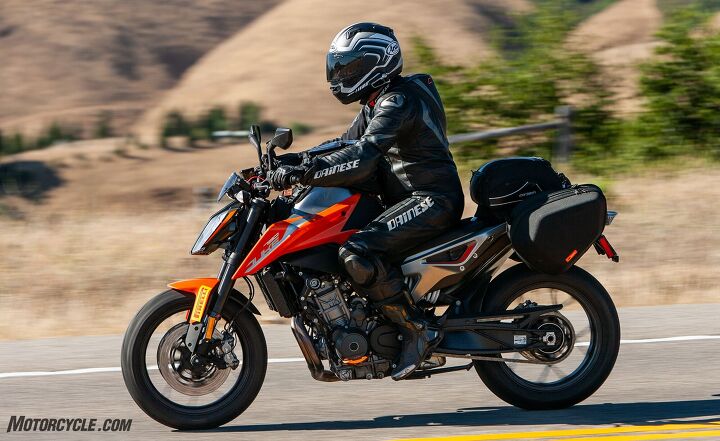






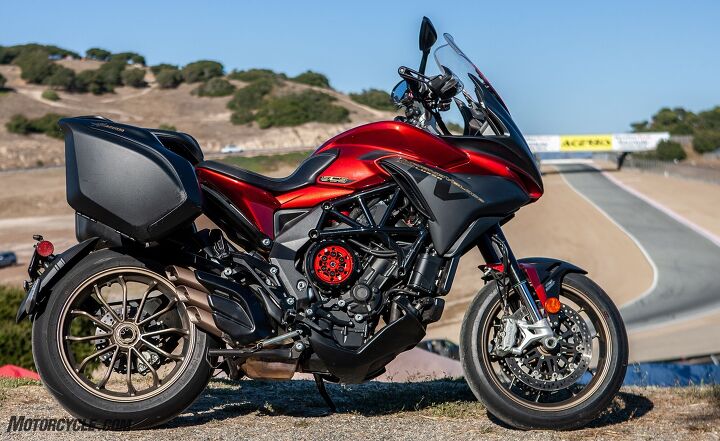








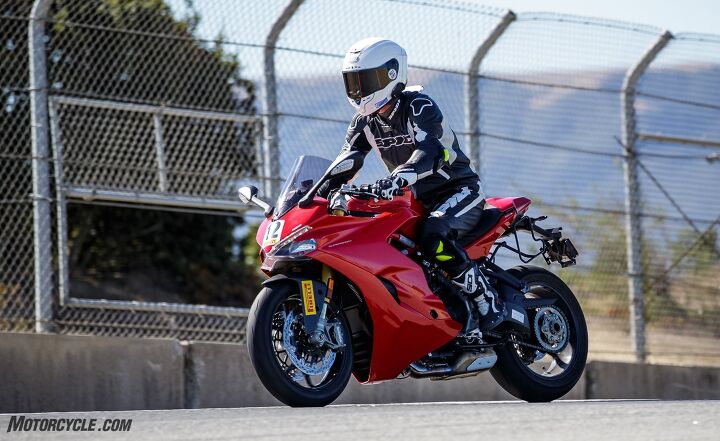




































































The post Writer’s Choice: MO’s WSBK Sport-Touring Showdown appeared first on Motorcycle.com.
【Top 10 Malaysia & Singapore Most Beautiful Girls】Have you follow?
